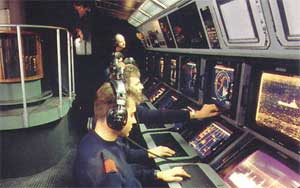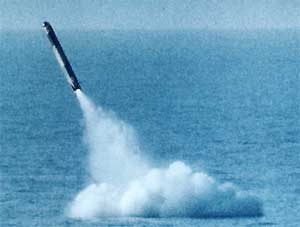|
Asia Times and the Times of India both report today the Taliban and al-Qaeda already have taken "virtual control" of the entire North Waziristan province of Pakistan and "declared" the establishment of an "Islamic state" in the area, gaining a major base for their operations against the U.S.-led forces in Afghanistan.
Osama bin Laden may be the most popular figure in the nation.
Just one man's life is preventing bin Laden or his allies from getting their hands not on nuclear weapons, which they already have, but a large nuclear arsenal and the means to deliver it anywhere in the world.
 His name is Pervez Musharraf, the president of Pakistan (pictured at right). His name is Pervez Musharraf, the president of Pakistan (pictured at right).
If fair-and-square elections were held today in Pakistan, and bin Laden or someone like him were allowed to compete, there is little doubt the populace would be with such a leader.
But they haven't had fair-and-square elections in Pakistan for some time – and President Bush, who promotes "democracy" as the antidote to terror, better hope they don't have one soon.
Pakistan not only has at least 40 nuclear warheads, according to most accounts, but it has some of the most sophisticated and feared delivery systems in the world.
Perhaps the biggest worry is the trio of French-built Agosta 90B stealth submarines, each capable of carrying 16 cruise missiles with nuclear payloads.
|
Pakistani Agosta 90B submarine |
The Pakistani military is very proud of its subs – and well they should be. They are at the top of the class for French submarines. They were designed by the French company DCN, which, as incredible as it may sound, has licensed Pakistan to produce more at a commercial base.
The project was completed despite a suicide bomb attack that killed 11 of the project's French engineers in front of their Karachi hotel in May 2002. The deal had to be approved by the U.S. government because the sub contains U.S. parts.
While the specs for the Agosta 90B subs say it is equipped to fire Exocet missiles and torpedoes, at a press briefing following the annual naval exercise Seaspark-2001, Rear Adm. Mohammad Afzal Tahir, the deputy chief of naval staff for operations, announced that the Pakistan navy was considering equipping its submarines with nuclear missiles. He suggested the Agosta 90B submarine, with its air independent propulsion system, can deliver nuclear weapons.
AGOSTA SUBMARINE
SSK AGOSTA 90B CLASS ATTACK SUBMARINE, FRANCE
The Agosta submarines designed by DCN of France, are currently in service with the French, Spanish and Pakistan navies. The Agosta 90B is an improved version featuring higher performance and a new combat system. The new submarine features a higher level of automation, which has resulted in the ship's crew being reduced from 54 to 36. Other improvements include a new battery for increased range, a deeper diving capability of 350m resulting from the use of new materials including HLES 80 steel, and a reduced acoustic signature through the installation of new suspension and isolation systems.
Three Agosta 90Bs were ordered by the Pakistan Navy in September 1994. The first, Khalid (S137), was built at DCN's Cherbourg yard and was commissioned in 1999. The second, Saad, assembled at Karachi Naval Dockyard, was launched in August 2002 and commissioned in December 2003. The third, Hamza, which is being constructed and assembled in Karachi, is scheduled to commission in 2006. Work on the vessel was halted following a terrorist attack in May 2002, which killed 11 French engineers in Karachi, but has since restarted. The third submarine is being fitted with the MESMA air independent propulsion system, which will be retrofitted to the first two. The MESMA AIP has successfully completed Pakistan Navy acceptance trials.
Pakistan has been given a license by DCN to offer commercial production of the submarines to potential customers.
 SUBTICS COMMAND AND CONTROL SYSTEM SUBTICS COMMAND AND CONTROL SYSTEM
The Agosta 90B submarines are equipped with a SUBTICS fully integrated combat system. This is supplied by UDS International, a joint subsidiary of DCN International and Thales (formerly Thomson-CSF). SUBTICS processes signals from the submarine's sensors, determines the tactical situation by track association, fusion, synthesis, trajectory plotting and management and handles all weapon command and control functions.
TORPEDOES
The Agosta 90B submarine is fitted with four bow 533mm torpedo tubes and has the capacity to carry a mixed load of up to 16 torpedoes and missiles. The submarine can be equipped with the ECAN F17 Mod 2 torpedo, which is a wire-guided torpedo with active and passive homing to a range of 20km. The torpedo delivers a 250kg warhead to a depth of 600m.
 MBDA EXOCET SM39 MISSILES MBDA EXOCET SM39 MISSILES
The Agosta 90B is equipped with the torpedo tube launched MBDA (formerly EADS Aerospatiale) Exocet SM39 missile. Target range and bearing data is downloaded into the Exocet's computer. The missile approaches the target area in sea-skimming mode using inertial navigation and then active radar homing. The missile approaches the target at speeds over Mach 0.9 and range is 50km. Exocet has a 165kg high-explosive shaped charge warhead.
ELECTRONIC WARFARE
The Agosta 90B submarines are equipped with the Thales DR-3000U radar warning receiver, operating in D to K bands. The system uses a masthead antenna array with omnidirectional and monopulse directional antennae and a separate periscope warning antenna.
SENSOR SUITE
The submarine is fitted with a Thales Underwater Systems (formerly Thomson Marconi Sonar) TSM 223 sonar suite, which includes bow-mounted sonar and towed sonar arrays, SAGEM periscopes and navigation system and Thales I-band navigation radar.
PROPULSION SYSTEMS
The Agosta 90B class submarines can be equipped with a diesel-electric propulsion system or the MESMA air-independent propulsion system. The diesel-electric system consists of two SEMT-Pielstick 16 PA4 V 185 VG diesels providing 3,600hp and a 2200kW electric motor driving a single propeller..
A diesel-electrical submarine has to surface to periscope depth to recharge the batteries using the diesel engine, leading to increased risk of detection. The MESMA air-independent propulsion system, being fitted to the Agosta 90B submarines for Pakistan, allows the submarine to remain submerged three times longer. The MESMA system consists essentially of a turbine receiving high-pressure steam from a combustion chamber, burning a gaseous mixture of ethanol and liquid oxygen. The Agosta 90B's performance remains the same in all other respects, except that the length increases from 67m to 76m and submerged displacement from 1,760t to 2,050t.
Back
to Main News Page |